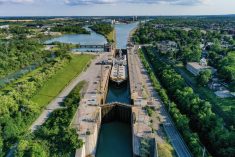A federal/provincial action plan to reduce phosphorus loading in Lake Erie has been released for public comment — and many of its recommendations will have implications for farmers in the Lake Erie basin.
None of the numerous recommendations are particularly new or surprising and mostly call for using existing funding programs to encourage certain production practices.
Recommendations include programs under the next federal/provincial agriculture policy framework that would encourage phosphorus reduction strategies from a whole-farm, multi-BMP (best management practice) approach.
The plan, posted March 10, calls for Ontario to continue to support development of a 4R strategy, led by industry, encouraging farmers and applicators to apply the right source of nutrients at the right rate, right time and right placement.
Read Also

India slaps 30 per cent import duty on yellow peas
India has imposed a 30 per cent duty on yellow pea imports with a bill of lading date on or after Nov. 1, 2025.
The continually growing greenhouse sector, especially in the Leamington area, is believed to be a source of increased phosphorus and it’s recommended that the province continue working with greenhouse growers to encourage nutrient recycling and reduce phosphorus levels in discharges to watercourses flowing to Lake Erie.
Several programs have already been created to encourage best management practices already, including the Great Lakes Agricultural Stewardship Initiative and its Farmland Health Checkup program, as well as the Environmental Farm Plan program and nutrient management plans.
The action plan recommends the harmonizing and streamlining of programs to create a whole-farm approach versus piecemeal programs addressing different parts of farm operations.
Other program recommendations include the planting of more trees, restoring native habitats including wetlands and riparian habitat, while focusing efforts on priority watersheds where phosphorus loadings are high and natural cover is low.
Other recommendations include encouraging dam owners to explore managing dams to reduce phosphorus outputs, and for public lands to be managed to minimize phosphorus losses.
Algae blooms in Lake Erie have been creating greater concern, especially in wet years. Most of the problems affect U.S. cities and most of the phosphorus entering the lake also comes from U.S. watercourses.
The federal-provincial plan says about “84 per cent of total phosphorus loads and 82 per cent soluble reactive phosphorus loads to Lake Erie are contributed by the United States, with smaller contributions from Canadian sources.”
There are concerns that a proposed Trump budget in the U.S. that slashed environmental programs includes a potential 97 per cent cut to the Great Lakes Restoration Initiative.
The Canadian plan is available for comment on the Ontario Environmental Registry website until May 9.
— John Greig is a field editor for Glacier FarmMedia based at Ailsa Craig, Ont. Follow him at @jgreig on Twitter.













